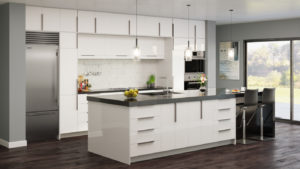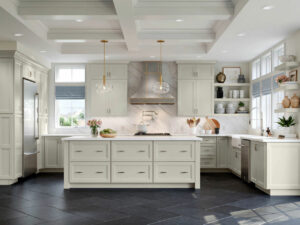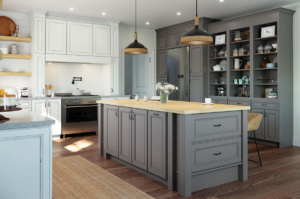
In the realm of kitchen design, where form and function harmonize to create spaces that are not only visually appealing but also highly functional, the kitchen island reigns supreme. A central hub for culinary creation, family gatherings, and even casual dining, the kitchen island has evolved into a multifaceted design element. Amidst the myriad of decisions that must be made when designing or renovating a kitchen, one often overlooked yet crucial detail is the inclusion of a toe kick in the kitchen island. In this comprehensive exploration, we will answer the question: Does a kitchen island need a toe kick?
Understanding the Toe Kick
The term “toe kick” refers to the recessed space located at the base of cabinetry, a design element that carries more significance than its unassuming name suggests. Typically measuring around 3.5 inches in height and set back approximately 3 inches from the cabinet’s front, the toe kick might appear to be a minute detail. However, its impact on kitchen aesthetics and ergonomic functionality is substantial.
 Ergonomics for Effortless Culinary Pursuits
Ergonomics for Effortless Culinary Pursuits
At the heart of the debate surrounding the necessity of a toe kick lies the concept of ergonomics. Picture yourself standing at your kitchen island, engrossed in chopping vegetables or kneading dough. Without a toe kick, the countertop’s proximity to your body would necessitate awkward postures and leaning over the island. The result? Potential discomfort and back strain after extended periods of culinary endeavors.
The toe kick, however, comes to the rescue. By allowing you to stand closer to the countertop, it promotes a more natural and comfortable posture. This not only enhances your culinary experience but also safeguards your physical well-being. Furthermore, the toe kick offers a designated space for your toes, enabling subtle shifts in weight and position without colliding with the cabinet base.
Aesthetics: Elevating Visual Cohesion
In the realm of kitchen design, aesthetics are as vital as functionality. Enter the toe kick, an often-unnoticed element that plays a pivotal role in enhancing the overall visual appeal of your kitchen.
The toe kick contributes to a streamlined and polished look. By employing materials and colors that harmonize with the cabinets, the toe kick creates a cohesive visual narrative that speaks to modern design sensibilities.
Furthermore, the toe kick can be harnessed to create visual illusions, particularly in smaller kitchens. By exposing more of the flooring, the toe kick can lend an airy and expansive ambiance to the kitchen, effectively tricking the eye into perceiving a larger space than it truly is—a strategic maneuver for compact layouts.
Beyond Aesthetics: Practical and Maintenance Perspectives
While the toe kick certainly adds to the aesthetic allure of your kitchen island, its practicality and ease of maintenance are equally significant factors to consider.
 Defending Against Wear and Tear
Defending Against Wear and Tear
As you navigate your kitchen, your feet often brush against the cabinet and island bases. Without a toe kick, these areas become vulnerable to scuffs, scratches, and unintended damage. In contrast, the inclusion of a toe kick acts as a protective barrier, safeguarding the base of your cabinetry and island from wear and tear over time. For those who invest in high-quality materials and craftsmanship, this added protection becomes invaluable in preserving the integrity of their kitchen’s appearance.
Maintaining Cleanliness with Ease
A clean kitchen is a happy kitchen. The toe kick aids in this endeavor by facilitating effective cleaning practices. Its recessed design ensures that you can sweep or mop beneath the cabinets and island without obstruction, leaving no nook or cranny untouched. However, some skeptics argue that the toe kick might accumulate dust and debris. This debate often hinges on personal cleaning habits and preferences, but the underlying fact remains: a toe kick allows for better access to the spaces that can otherwise be challenging to clean.
The Decision-Making Dilemma: Do You Need a Toe Kick?
As with most design choices, the decision to incorporate a toe kick in your kitchen island is not a one-size-fits-all matter. Various considerations come into play, each influenced by the intended functionality and design vision for your kitchen space.
Functional Priorities: The Culinary Workspace
If your kitchen island predominantly serves as a culinary workstation—think meal prep, baking, and cooking—the inclusion of a toe kick is highly beneficial. Its ergonomic advantages, which facilitate comfortable and efficient work postures, make it a crucial element for any workspace where extended periods of standing are common.
 Seating Scenarios: The Breakfast Bar Balancing Act
Seating Scenarios: The Breakfast Bar Balancing Act
For kitchen islands that double as breakfast bars or seating areas, the design dynamic shifts. In such cases, the inclusion of a toe kick might be dictated by the seating arrangement. While a toe kick could still be present beneath the workspace, its design or absence in the seating area might prioritize legroom and comfort for those seated.
Mobility Matters: The Movable Island
In some kitchen designs, mobility takes center stage. Mobile kitchen islands, designed for flexibility and adaptability, might forgo the traditional toe kick in favor of wheels or an alternative base structure. This approach optimizes the island’s portability while still accommodating its functional and design intentions.
Personalized Aesthetics: Custom Craftsmanship
For homeowners who prioritize unique and personalized design elements, the inclusion of a toe kick—or lack thereof—becomes a subjective choice. Custom-designed kitchen islands allow for a tailored approach, allowing you to align the toe kick’s presence with your individual aesthetic preferences and overall design narrative.
Bring Your Dream Kitchen to Life
Functionally, the toe kick offers ergonomic benefits that enhance the ease and comfort of culinary pursuits. Aesthetically, it contributes to a cohesive and polished design, while its practical attributes ease maintenance and protect against wear. However, the decision to incorporate a toe kick in your kitchen island is ultimately a reflection of your unique design vision, lifestyle, and functional priorities. Whether you opt for the streamlined elegance of a toe kick or choose to embrace a distinct design narrative without it, the essence of a well-designed kitchen lies in the delicate balance achieved between form and function.
If you are looking to bring your dream kitchen to life near the Greensboro, North Carolina area, contact us here at Kitchen Express. With over twenty years of experience, our team can bring your idea to life for less than you imagined and faster than you thought possible. Schedule a free in-home design consultation with us today to get started!
Contact Us
